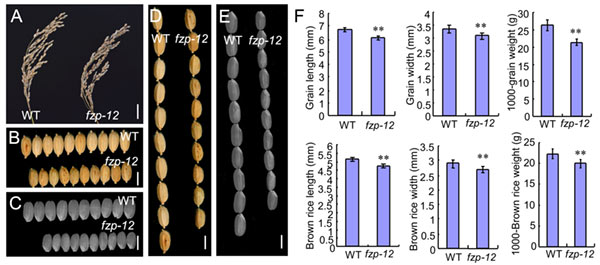






FZP determines Grain Size and Sterile Lemma Fate in Rice
November 19th, 2018

Three major components, panicle number per plant, grain number per panicle, and grain weight, determine rice yield. Grain size is an important agronomic trait that determines grain weight, but the regulatory mechanisms that control grain size are still largely unknown. Besides, the identities and origins of glumes, and the relationship between the rudimentary glumes, lemma, and sterile lemma are not yet fully understood.
Recently, researchers from China National Rice Research Institute (CNRRI) found that FRIZZY PANICLE (FZP) played a crucial role in determing grain size and sterile lemma fate in rice and verified that the lemma, rudimentary glume, and sterile lemma were homologous organs. In the study, researchers identified a new weak mutant allele of FZP and named it as fzp-12. The mutant showed different phenotypes compared with previously reported mutants, including small grains and degraded sterile lemmas. Further investigation revealed that the small fzp-12 grains were caused by a reduction in cell number and size in the hulls. In the meantime, it was found that the sterile lemma underwent a homeotic transformation into a rudimentary glume in the fzp-12 mutant while the sterile lemma underwent a homeotic transformation into a lemma in FZP over-expressing plants, firstly providing clear evidence in support of the hypothesis that the lemma, rudimentary glume, and sterile lemma are homologous organs.
The paper entitled FZP determines Grains Size and Sterile Lemma Fate in Rice is published online in Journal of Experimental Botany. This study was supported by grants from the National Natural Science Foundation of China (31521064 and 91735304), the National Science and Technology Major Project (2016ZX08009003-003-008), the Zhejiang Natural Science Foundation (LY18C130007), the National Natural Science Foundation of China (31671666), and the National GMO New Variety Breeding Program of PRC (2016ZX08011-001). More details are available on the link below: https://onlinelibrary.wiley.com/doi/full/10.1111/pbi.12849.
· Study Reveals How the Clock Component OsLUX Regulates Rice Heading
· Scientists Further Unravelled the Underlying Mechanism of Heading Date Control in Rice
· Improving the efficiency of prime editing in rice
· A New Infection Mechanism of Ustilaginoidea virens is Revealed
· Scientists Further Reveal the Infection Mechanism of Ustilaginoidea virens
CNRRI Today
Copyright © 2014- China National Rice Research Institute